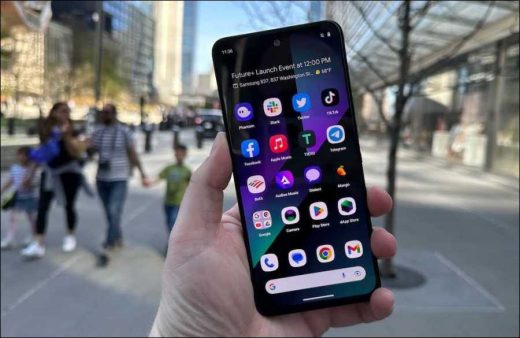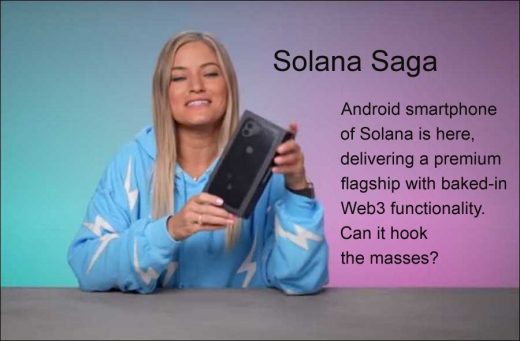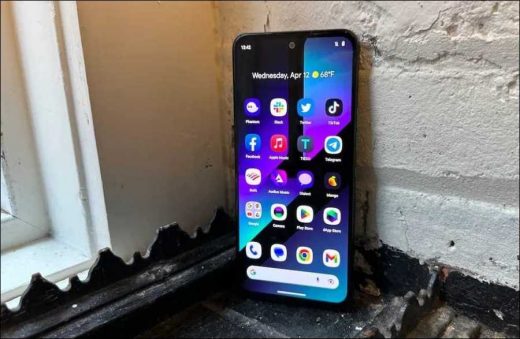Solana Saga. Android phone of Solana is here, delivering a premium flagship with baked-in Web3 functionality. Can it hook the masses? It’s here: Solana really did make its own Web3 smartphone, the Saga—and it’s rolling out now to people who pre-ordered, with new orders set to begin May 8.
We have had its hands on the $1,000 Android flagship device for the past week—and right now, Solana Labs’ “moonshot” bet feels mostly like a Web2 device with a splash (albeit a meaningful one) of Web3 integration. It’s a capable, powerful phone with native, secure wallet functionality that feels tight and intuitive, but with few available apps plus some hitches along the way.
Even more so than usual in Web3, using the Saga today feels like beta testing something with promise and potential. That may be an intriguing premise for early adopters and die-hards, and a potential catalyst for developers, but potentially a tough sell for the average consumer—and Solana Labs knows it. But there’s a lot to like here, even if it feels a bit early.
As a longtime tech reviewer and someone who always wields a top-end handset, one of my key considerations when evaluating a phone is whether I could live with it on a day-to-day basis. In other words, would I be happy carrying this thing in my pocket as I stay connected, snap photos, work remotely, and remain perpetually online? Luckily, the Solana Saga meets that requirement. This is a premium Android flagship with an attractive (but not overly flashy) design, built with sturdy materials and packed to the gills with just about everything you’d need to communicate, stay connected, and be entertained. Even without the Web3 element, this would be a very good Android phone. At a glance, the Saga is less distinctive than the Samsung Galaxy S23 or recent iPhones, but little accents help set it apart—the metallic green side buttons and rounded triangular titanium camera module on the back, especially. The stainless steel frame and ceramic backing are nice touches, too, even if the matte black rear finish is a fingerprint and smudge magnet. It’s a big boy, too—slightly taller and heavier than my iPhone 14 Pro Max, with a bright 6.67” 1080p AMOLED screen with a smooth 120Hz display. Battery life is pretty robust and reliable here with a beefy 4,110mAh cell, with wireless charging available for convenience alongside a faster wired USB-C connection. The Saga’s ceramic backing is a smudge magnet. Image: Decrypt You’re unlikely to notice the difference now, but the Saga could be less resilient than some 2023 rivals in the future as more demanding apps and games launch. On the upside, however, the Saga is packed with a robust 512GB of internal storage as standard—most phones require an upcharge to get you that kind of onboard storage. The dual-camera setup, with a 50-megapixel main shooter and 12MP ultrawide camera alongside, met my needs for casual everyday snaps, delivering crisp details and punchy colors. Put side by side with the iPhone 14 Pro Max, however, Apple’s shots were routinely sharper, with more natural color balance. Aside from the Web3 elements, the Saga ships with a thankfully clean Android 13 build—no clunky skin, no bloatware junk—and the full suite of Google services, including the Play Store. And this 5G phone works with all major U.S. carriers, so you can take it where you please. That’s the standard, “Web2” side of the Solana Saga experience—and if you plan to use it as an everyday phone, that’s really the most important piece of the puzzle. But it’s the Web3 integration that sets the Saga apart from your typical smartphone, and the key reason why anyone would consider the Saga over a standard flagship. The Saga’s Web3 offering is built around the Seed Vault, a native custody solution that secures your wallet’s seed phrase within a secure environment on the phone. Even the Android operating system doesn’t have access, and it’s tied to your biometric signature via the rear fingerprint sensor. That’s paired with a native store for decentralized apps (dapps), which has just over a dozen dapps right now but provides a smoother, easier-to-use flow than typical web apps. Using a wallet app like Phantom or Solflare, you can sign Solana network transactions with a touch of the sensor, along with a tap of the screen and occasional PIN entry for good measure. Why Solana Is Going Big on Mobile—And Making a Smartphone Setting up a wallet and getting started is relatively straightforward here thanks to a simple onboarding process, and within minutes, I was swapping USDC for Solana (SOL) via the Jupiter swap aggregator dapp and buying NFTs through the Tiexo marketplace. I took a photo amid the mayhem of Times Square and then immediately minted it as an NFT via the Minty Fresh dapp. Views: 89
The Saga is plenty fast and powerful too, thanks to a flagship-level Qualcomm Snapdragon 8+ Gen1 processor paired with 12GB RAM, making it capable of running games and demanding apps with ease. That said, it’s not the top-of-the-line chip: the Galaxy S23 and other new phones run a Gen2 chip that delivers solid performance gains in benchmark testing.Web3 on the go
Solana’s teasers leading up to yesterday’s “SMS” event suggested something to do with mobile, but few could have imagined the twist that was announced in New York City. Yes, Solana Labs has built a mobile software platform… but it’s also releasing a smartphone. Solana Labs yesterday revealed the Solana Mobile Stack (SMS) software kit, which provides tools for developing native Android mobile apps, walls, and games, and also includes a decentralized app store. The company also revealed the Saga,…





